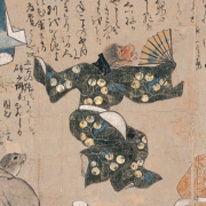Past Exhibitions
- Going Ape for the Year of the Monkey Part 2: Dancing Monkeys
- December 15, 2015 - January 24, 2016
From the end of the Muromachi Period (1336-1573) into the Edo Period (1603-1868), a common element of Mibu Kyogen, a form of pantomime that is among Kyoto's classic folk arts, involved a perfomer dressed as a monkey performing various stunts such as walking a tightrope. It is thought that belief in the supernatural power of monkeys underlay this aspect of folk culture. However, over time performing arts like this one gradually lost their religious significance and came to be pure entertainment, while monkeys came to be seen less as sacred than as foolish and comical, as expressed by the proverb saru wa ningen ni ke ga misuji taranu (literally "a monkey is three hairs short of a man," meaning inferior to a human being.) This section showcases art from the medieval period, illustrating people’s attitudes toward monkeys, which eventually evolved into amusement at what they perceived as their clownish antics.












